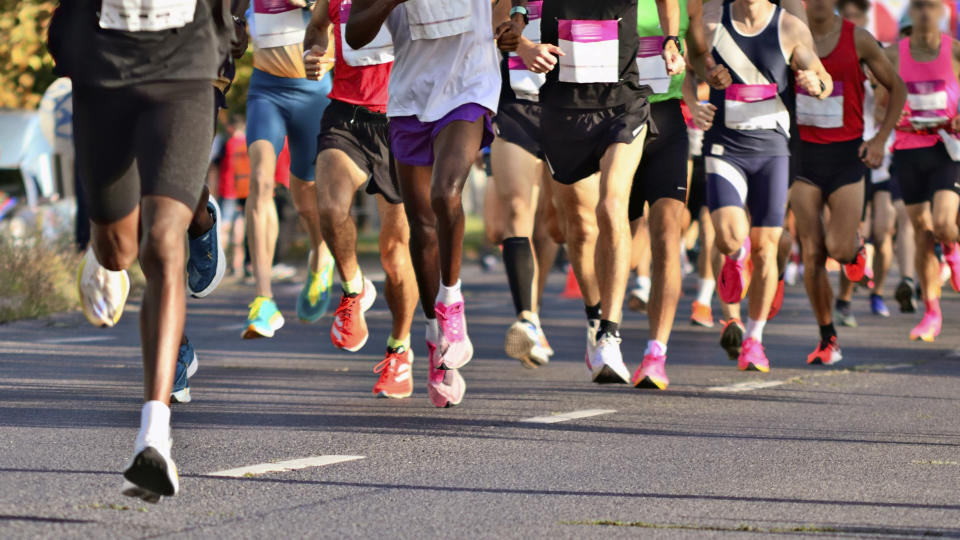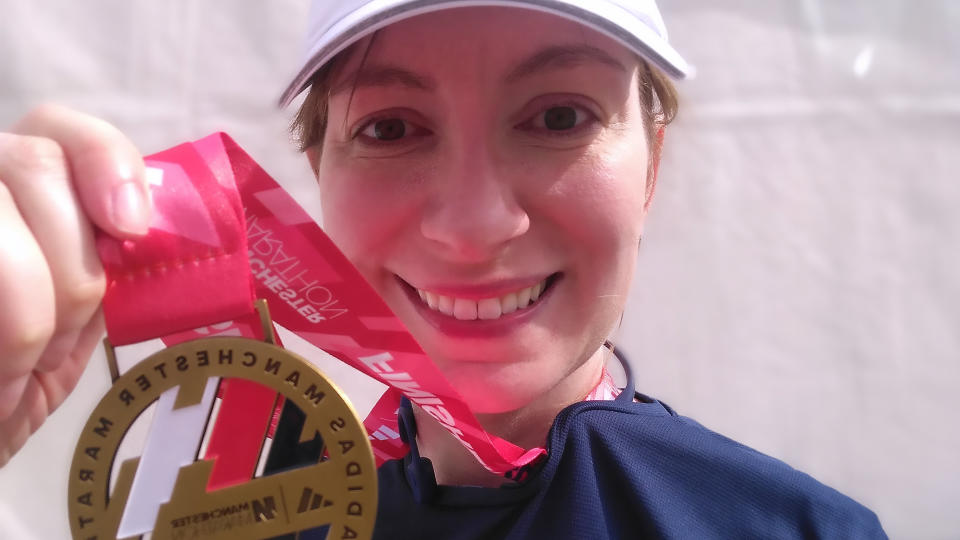Two things that helped me knock over 40 minutes off my marathon time

Just over a week ago, I crossed the line at the Manchester Marathon. I was exhausted but delighted, having knocked over 40 minutes off my previous personal best and raised almost £700 for the Alzheimer's Society.
It was a wonderful charity to support, but I must confess that my main motivation was embarrassment. I've run countless 10ks and half marathons, but until last week I only had one full marathon under my belt (the Bristol + Bath Marathon back in 2005) and it wasn't a good one.
Things started off well, and I stuck to my planned pace, but somewhere around mile 20 something suddenly went wrong around the left gluteal area, leaving me in great discomfort and silently cursing the encouraging words of other runners reminding me that there was a downhill section approaching. It was a literal pain in the butt.
In the final few miles, where many of my friends were marshalling, I forced myself to pick up the pace and look like I was enjoying myself, but my time was dismal. The race itself proved to be a one-off too, with the organizers cancelling the 2006 and 2007 events, then calling the whole thing off.
This year I took a different tack, with two main changes. Firstly I found and followed a training plan specifically designed for the time I was hoping to achieve, and secondly I sought out coaching sessions to help tackle the underlying physiological issues that led to my race-day glute problems.
Trying TrainingPeaks
For my first marathon I did most of my training with a friend, and although training together was fun and made the long miles pass faster, it didn't quite work out for us, and the plan wasn't as structured as it could have been. We built up the mileage, but I now realize there weren't enough intense interval or hill workouts, and we didn't have much of a plan for tapering. My buddy had to drop of marathon training this year due to an ongoing injury, so for Manchester 2024 I knew I'd be going it alone.
There's no shortage of marathon training plans online, but I wanted to minimize the time spent on admin, so I signed up for TrainingPeaks, picked a plan that fitted my level of fitness and goal, and synced the workout calendar with my Garmin watch. From then on, all I had to do was select the day's workout and let the watch lead me through each stage, ensuring I stuck in the right heart rate zone and warning me if I was slacking or needed to slow down.

Last year I took part in a VO2 max test that included calculation of my heart rate zones, so I was able to enter these in my Garmin profile for improved accuracy.
I made sure I started my plan well in advance so I could build in space for things like holidays and potential sick days. You'll only be able to shift your training days in big blocks if you have a premium TrainingPeaks subscription, but I found it was worthwhile to have that flexibility.
It was gratifying seeing how my fitness improved over time, the longest runs became more comfortable, and my Garmin Endurance Score embarked on a steady climb as race day approached. It wasn't always easy or fun, but with a pair of good running headphones and a carefully curated playlist of cheesy rock music, I got there.
Strength and technique
Cardiovascular fitness was only one part of the puzzle, though. There was still a pain in the butt that needed to be addressed. Running 26.2 miles will certainly uncover any significant weaknesses or imbalances in your musculoskeletal system.
Having listened to my fretting at length, my husband bought me a 10-session course with The Running School in Bristol as a birthday present. I wasn't really looking forward to hearing that I was running completely wrong, but thankfully the physiotherapist, a lovely chap named Alex, never made me feel awkward or foolish, and always reminded me that there's no single correct way to run.
First, he made me perform a few drills to assess strength and stability, then got my on the treadmill running at various speeds. He then sat me down, looked me in the eye, and asked with terrible gravity whether I'd seen myself running on a treadmill before. I had (for the VO2 max test) so it wasn't as awful as he made it sound, but as he drew lines on the screen, a few problems became clear - particularly an asymmetrical rotation of my hips. I wasn't lifting my feet much either, my posture wasn't ideal, and I was over-striding, landing well ahead of my center of gravity. Oops.

Alex led me through some strengthening exercises for my weak side, which initially involved resistance bands and bodyweight, but eventually worked along to small kettlebells. After each session I was set homework in the form of a workout plan, to be followed as I built up my mileage.
He also got me back on the treadmill and suggested ways to improve my form - improving my posture, focusing on keeping my shoulders relaxed but moving my arms back more, and cycling my legs. It felt strange at first (having run one way for years, change doesn't come naturally) but eventually it began to come more naturally.
Comparing the first video of myself to one recorded during my final session, the difference is stark. The first video now looks like a person trying to speed-walk with their neck stuck out like a turtle, while the later one looks like someone actually running. I no longer over-stride, my hips are more stable, my posture is better, and I'm moving more efficiently all round.
The real proof of the pudding, however, was in the lack of pain as the mileage crept over 20 miles, and on race day itself, although I was certainly exhausted by the end, there was no sign of the pain from nine years ago. Now I can't help wondering how much I could knock off next year...
The best road running shoes: our top recommendations

